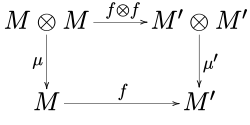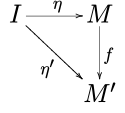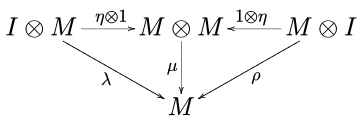Monoid (category theory)
In category theory, a branch of mathematics, a monoid (or monoid object) (M, μ, η) in a monoidal category (C, ⊗, I) is an object M together with two morphisms
- μ: M ⊗ M → M called multiplication,
- η: I → M called unit,
such that the pentagon diagram
and the unitor diagram
commute. In the above notation, I is the unit element and α, λ and ρ are respectively the associativity, the left identity and the right identity of the monoidal category C.
Dually, a comonoid in a monoidal category C is a monoid in the dual category Cop.
Suppose that the monoidal category C has a symmetry γ. A monoid M in C is commutative when μ o γ = μ.
Examples
- A monoid object in Set, the category of sets (with the monoidal structure induced by the Cartesian product), is a monoid in the usual sense.
- A monoid object in Top, the category of topological spaces (with the monoidal structure induced by the product topology), is a topological monoid.
- A monoid object in the category of monoids (with the direct product of monoids) is just a commutative monoid. This follows easily from the Eckmann–Hilton argument.
- A monoid object in the category of complete join-semilattices Sup (with the monoidal structure induced by the Cartesian product) is a unital quantale.
- A monoid object in (Ab, ⊗Z, Z), the category of abelian groups, is a ring.
- For a commutative ring R, a monoid object in
- (R-Mod, ⊗R, R), the category of modules over R, is an R-algebra.
- the category of graded modules is a graded R-algebra.
- the category of chain complexes of R-modules is a differential graded algebra.
- A monoid object in K-Vect, the category of K-vector spaces (again, with the tensor product), is a K-algebra, and a comonoid object is a K-coalgebra.
- For any category C, the category [C,C] of its endofunctors has a monoidal structure induced by the composition and the identity functor IC. A monoid object in [C,C] is a monad on C.
- For any category with finite products, every object becomes a comonoid object via the diagonal morphism . Dually in a category with finite coproducts every object becomes a monoid object via .
Categories of monoids
Given two monoids (M, μ, η) and (M', μ', η') in a monoidal category C, a morphism f : M → M ' is a morphism of monoids when
- f o μ = μ' o (f ⊗ f),
- f o η = η'.
In other words, the following diagrams


commute.
The category of monoids in C and their monoid morphisms is written MonC.[1]
See also
- Act-S, the category of monoids acting on sets
References
- Section VII.3 in Mac Lane, Saunders (1988). Categories for the working mathematician (4th corr. print. ed.). New York: Springer-Verlag. ISBN 0-387-90035-7.
- Mati Kilp, Ulrich Knauer, Alexander V. Mikhalov, Monoids, Acts and Categories (2000), Walter de Gruyter, Berlin ISBN 3-11-015248-7

